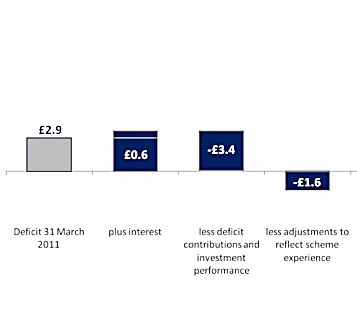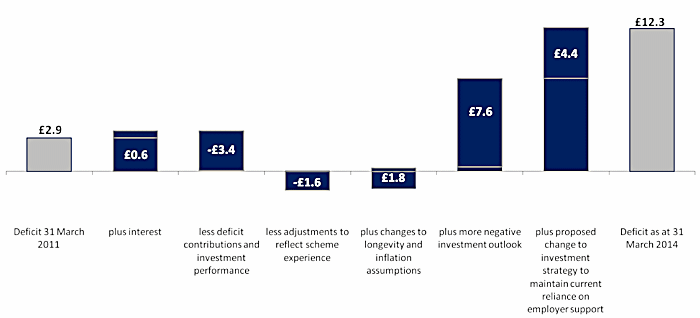Disputed 2014 valuation of USS
This page is an attempt to summarise the disputed 2014 valuation of the Universities Superannuation Scheme (USS), the main pension fund for academic and related staff in pre-92 universities. It also attempts to collate relevant resources.
(Last updated 11 March 2015)
The position according to the USS board
Every three years the USS fund must undertake a valuation to assess its long-term prospects. This involves
- estimating the fund’s liabilities (payments to be made, present and future);
- comparing to a forecast of the fund’s assets (contributions received, past and future).
Both of the above involve predictions, including how invested assets and wages will grow, what will happen to interest rates, how long people will live and more. The assets should be larger than the liabilities (a surplus); a shortfall is known as a deficit.
In March 2011, the official valuation showed a £2.9bn deficit. This resulted in a ‘rescue plan’: the final salary scheme was replaced with a cheaper but inferior career average one for new joiners, and monthly contribution rates for staff and universities increased.
Despite the 2011 rescue plan, the March 2014 draft valuation showed an even bigger deficit of £12.3bn. To deal with this, there is a proposal to scrap the final salary scheme for all, increase contribution rates again and introduce a ‘defined contribution’ element to the scheme.
Controversy
The USS board argue that the current scheme is unaffordable and urgent change is necessary. However, a growing amount of analysis suggests that the methodology used to value the fund is seriously flawed. In particular, key assumptions on investment performance, wage growth, interest rates and more are highly questionable. Under most sensible-looking and prudent assumptions, the scheme shows a surplus (see [5]).
The assumptions which show the existence of the deficit are, it is argued, not well justified, not evidence based, and vastly underestimating the health of the fund.
Unsurprisingly, UCU have been highly critical of the methodology, and an actuarial report they commissioned [10] runs to 43 pages of rigourous criticism. In addition, universities including Oxford, Cambridge, Warwick and Imperial have expressed strong levels of dissatisfaction. Other institutions have expressed varying levels of concern and the umbrella body Universities UK (UUK) which represents the universities has also queried the assumptions used in the valuation in their response to the USS board [13].
The deficit breakdown
The following graphic appears in [12], produced by USS. It gives a break-down of how the £2.9bn deficit of 2011 became a £12.3bn deficit in 2014. The break-down can be thought of in two halves: four columns representing the experience over the three years to 2014, and four columns representing modified predictions for the future.
Let’s start with what has actually happened since 2011.

The scheme’s health has outperformed expectations significantly since March 2011. Invested assets performed well and wage growth was low. The rescue plan intended to reduce the deficit to zero has instead led to a surplus. From this, it is not clear whether the identification of a deficit in 2011 was correct in the first place.
The figures above show that, if the forecasting assumptions stay as in the 2011 valuation (which experience proved to be overly pessimistic in the following three years), there is now a surplus of around £1.6bn. If the fund continues to perform this way, the surplus will grow at subsequent triennial valuations.
So where’s the £12.3bn deficit? It appears when the assumptions on future performance are further downgraded.

Not only are investment predictions lowered, adding £7.6bn, but a guiding principle known as ‘Test 1’ newly introduced by USS in 2014 forces the scheme to look for lower return investments, regardless of whether or not the current investment strategy is seen as prudent and profitable, ramping the deficit up by an extra £4.4bn.
The content of the assumptions contributing to the large deficit have been put under close scrutiny by actuaries commissioned by UCU, statisticians and financial mathematicians at Warwick University, and a working group of academics with relevant expertise at Imperial among others. One major contention is the assumption on the ‘discount rate’, the predicted rate of investment growth, which appears not to have been based on investment forecasts but instead tracks the UK gilt market in a calculation (‘gilts+’) which was calibrated in 2011, but, as far as the details are known, has not been adjusted to account for a fall in gilt yields since then.
Further reading
Most of the writing on this issue references either the USS draft valuation document [9] or the UCU-commissioned actuarial analysis [10]. The latter is, arguably, the essential reading on the matter. However, both documents may be too technical for some readers, and are quite long.
For most, the best starting point is probably the letters co-authored (among others) by Jane Hutton and Saul Jacka of Warwick University, and the response they’ve received from Bill Galvin, Chief Executive of USS. The THE letter [1] is a non-technical overview which summarises their concerns, and [2] fleshes out the details.
- [1] False Assumptions of the USS, letter to Times Higher Education, October 2014
- [2] Letter to Martin Harris, Chair of the USS board, November 2014
- [3] Reply from Bill Galvin, Chief Executive of USS, December 2014
- [4] Response from Jane Hutton and Saul Jacka, January 2015
Imperial College London commissioned five of its academic staff with relevant expertise to provide their analysis. The resulting report [5] finds the health of the fund to be highly sensitive to variations in assumptions, and influenced Imperial’s strongly worded response to the negotiation process [6].
- [5] Report on USS Pension Valuation, Working party on pension valuation, Imperial College, November 2014
- [6] Imperial College response to the negotiations, November 2014
Other interested parties writing on this matter include Dennis Leech of Warwick University, whose blog [7] addresses many relevant points, and Mike Otsuka of LSE who has focussed on the pernicious effects of ‘Test 1’ [8].
- [7] Dennis Leech’s blog, ongoing
- [8] How to value a pension fund for an ongoing pre-92 higher education sector that is not about to become insolvent, Mike Otsuka, March 2015 (updated)
Documents produced by USS, UCU and UUK can be found below. These include USS’s 2014 draft valuation [9] and the UCU actuarial analysis [10] (which should be read side-by-side) amongst other things.
- [9] USS 2014 Actuarial Valuation, USS, October 2014
- [10] Report to the USS paper: 2014 Actuarial Valuation, First Actuarial for UCU, November 2014
- [11] USS Valuation as at March 2014, factsheet from UCU, September 2014
- [12] 2014 Formal Valuation: Information for members, USS, December 2014
- [13] Response to the USS Consultation on Technical Provisions and Recovery Plan, UUK, December 2014
Looking at the bigger picture, a Bank of England report recently found that the short-termist investment strategies of pension funds have amplified market volatility and reduced the amount of long-term funding available for industry and infrastructure, having a destabilising effect on the wider economy. This adds more weight to criticism of the current ‘mark-to-market’ approach.
- [14] Riders on the storm, Ashok Gupta, The Actuary magazine, March 2015
You can find the staffside unions’ response to the 2014 consultation below.
- [15] Union comments on the USS consultation, Sheffield UCU, Unite and UNISON, May 2015